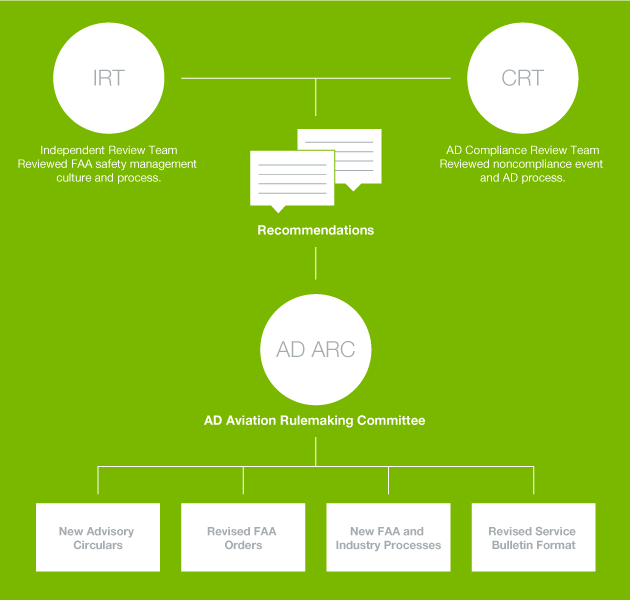

The Airworthiness Directive (AD) Implementation Aviation Rulemaking Committee (ARC) was chartered by the U.S. Federal Aviation Administration (FAA) to implement recommendations resulting from an investigation into the grounding of numerous airplanes because of AD noncompliance.
The Aviation Rulemaking Committee is changing how airworthiness directives are developed and implemented.
The purpose of the AD ARC was to develop and implement solutions that would improve airline compliance with FAA ADs. Improvements include clearly identifying the critical steps required for AD compliance, adding flexibility and standard practices to reduce the need for alternative methods of compliance (AMOCs), providing FAA inspectors with better tools to determine compliance, and communicating best practices for operators when planning and performing inspections and modifications mandated by an AD. In all, the committee is implementing more than 30 changes to processes and procedures affecting the FAA, original equipment manufacturers (OEMs), operators, and maintenance providers.
This article highlights these changes and how the success of the AD ARC is expected to improve the current process for developing and implementing ADs.
Background
During March and April 2008, two cases of potential noncompliance to ADs resulted in hundreds of airplanes being grounded, inconveniencing thousands of passengers. This prompted the U.S. Department of Transportation to establish an Independent Review Team (IRT) to examine the FAA’s safety culture and its implementation of safety management. The IRT consisted of five aviation and safety experts who were tasked with evaluating and making recommendations to improve the FAA’s implementation of the aviation safety system and its culture of safety. The IRT issued its final report in September 2008, identifying recommendations related to ADs, the voluntary disclosure program, the culture of the FAA, safety management systems, the air transportation oversight system, and the role of FAA inspectors.
Soon after the IRT was formed, the FAA also established an AD Compliance Review Team (CRT) to review the events that caused the major disruption to some airlines’ schedules. This team consisted of eight FAA and industry subject matter experts. The team first reviewed compliance issues related to a model-specific AD and then reviewed the general process for developing and implementing ADs. The team’s findings show that the AD processes within the FAA and within the manufacturing and air carrier industry have worked well over the years. However, during this review the team uncovered areas where improvements can be made. The team created two reports (see fig. 1) with findings and recommendations for improvements. These recommendations focus on the areas of service instructions, the FAA Aircraft Evaluation Groups (AEGs), lead airline process (i.e., Air Transportation Association Specification 111), AD process and implementation, mandatory continuing airworthiness information, AMOCs, crisis communication, and Part 39 regulations.
Figure 1: AD ARC process
The U.S. Department of Transportation established an Independent Review Team (IRT) followed by an Airworthiness Directive (AD) Compliance Review Team (CRT) that was established by the FAA. Findings and recommendations for improvements from these two teams were sent to the AD Aviation Rulemaking Committee, which was tasked with implementing the recommendations.

AD Implementation ARC
In August 2009, the FAA chartered the AD ARC to evaluate and address the recommendations of the AD CRT and IRT relating to airworthiness directives. The AD ARC had its first meeting in December 2009 with members including the FAA, various airplane manufacturers, airlines, and industry associations. It was tasked with implementing the recommendations by June 30, 2011.
Working groups. The ARC divided the recommendations into four categories and created four associated working groups: service information, AD development, AD implementation, and FAA organization/procedures. Working group members included people from various airlines, design approval holders, the FAA, and industry associations. The objectives of the working groups were:
- Service information. Revise the way service bulletins (SBs) are written to avoid mandating actions that are not required to meet the safety intent of the AD.
- AD development. Ensure that the AD development process is effective and efficient.
- AD implementation. Identify and develop guiding principles, processes, procedures, and best practices for implementing and maintaining compliance with ADs to ensure a safe product.
- FAA organization/procedures. Define decision-making processes for compliance versus noncompliance that can be used by the FAA and industry in any situation.
Service Information Working Group
The Service Information Working Group was co-led by Boeing and a major U.S. airline. This group’s efforts will result in significant changes to the way Boeing SBs are written, especially those associated with ADs. These changes and best practices are being written into an FAA advisory circular (AC) with strong encouragement for all design approval holders to make similar changes. These changes include:
- Writing SBs to clearly identify which accomplishment steps are required to correct the unsafe condition that prompted the AD and which steps can be performed using acceptable procedures. This will allow airlines to use their own accepted practices for steps such as access and close-up. It should also reduce the need for AMOCs for work done during a heavy visit when the airplane is already opened up, and other similar situations.
- Adding notes to SBs that allow flexibility in using acceptable equivalent alternate materials, parts, and procedures where allowed. General notes have been used in SBs for years, but this effort is creating new notes and expanding existing notes to allow for the maximum amount of flexibility when accomplishing the SB instructions. For example, this may eliminate the need for AMOCs to use alternate fasteners or change the sequence of steps in a procedure, or when gaining and restoring access to accomplish a modification.
- In addition to adding general notes, SBs will be written using standard industry practices whenever possible, instead of unique materials or processes. This will make it less likely for work to be accidentally undone during normal maintenance.
- Figures and illustrations will be identified as either “authoritative” or “reference only,” communicating more clearly when the airplane configuration must match the illustration.
- Best practices are being shared among the design approval holders serving on the working group to help streamline the processes for developing and revising SBs.
- The lead airline process is being enhanced to improve the coordination of corrective action necessary to correct an unsafe condition before the SB and AD are released.
AD Development Working Group
This working group was led by the FAA and was tasked with making the AD process more effective and efficient. Changes that either already have been completed or are being implemented include:
- FAA Notice 8110.112, which discusses the FAA posting of service information that is “incorporated by reference” in ADs onto the Federal Docket Management System (FDMS) at the final rule stage. This gives public access to bulletins containing work instructions mandated by ADs. It also allows the FAA to post service information onto the FDMS at the Notice of Proposed Rulemaking (NPRM) stage with permission from the design approval holders. Boeing has granted the FAA permission so that during the NPRM comment period, commenters will have the appropriate information needed to review the requirements before commenting. This will apply to new ADs only; it is not retroactive.
- A process developed by the FAA and OEMs for tracking and managing multiple AD-related SBs that may conflict or overlap. This will help to avoid potential confusion, inadvertent noncompliance, or reversal of previous AD actions.
- A formalized process for documenting within the AD whether credit is given for accomplishing earlier versions of the related service information. This will help reduce the number of AMOCs.
- The FAA has clarified in the AD manual what is meant by ex parte (“one-sided”) communications and how it relates to commenting on rule changes. This will provide awareness of the proper documentation during rulemaking.
The Service Information and AD Development Working Groups are working jointly to document in the AD what is necessary after accomplishment of the AD to either maintain the exact configuration defined by the AD or whether standard maintenance practices can be used. This effort was an add-on from the IRT and CRT recommendations and may take additional time to work through the details of the implementation.
AD Implementation Working Group
A major U.S. airline headed up this working group. It took the best practices from all the groups’ participants and is including them into an FAA AC so that all operators can adopt them. The AC will include the following guidance related to best practices for air carrier AD compliance planning, implementation, and monitoring:
- FAA aviation safety inspector (ASI) involvement in air carrier AD management processes.
- Air carrier prototyping of AD documentation prior to implementation in order to ensure work efficiency and AD compliance.
- Periodic audits of AD compliance by air carriers with a focus on ADs with a high risk of inadvertent alteration during normal maintenance.
- Training on AD processes and wiring best practices.
- Air carrier skill-specific training for particular ADs.
- OEM and air carrier best practices when requesting AMOCs.
- Identification of opportunities to make more AMOCs global when appropriate and posting of these AMOCs on OEM websites.
- 24/7 crisis communication process among air carriers and FAA Flight Standards Service field offices to prevent potential grounding situations.
Incorporation of these best practices will help to improve the overall process for AD implementation and reduce noncompliance findings and the need for AMOCs.
FAA Organization/Procedures Working Group
This team was led by the FAA and focused on making changes to the way the FAA manages ADs. This team’s functions included:
- Strengthening the role of the FAA AEG by:
- Clarifying AEG roles and responsibilities in FAA Order 8900.1 (Flight Standards Information Management System). The AEG specialist will be involved earlier in the AD process, which will help the AEG determine when an outreach program to the principal inspector is needed.
- Developing new AEG classroom and Web-based training regarding AEG roles and responsibilities and their interfaces with the Aircraft Certification Office (ACO). The training program would define the communication protocol and elaborate on the responsibilities and positions of each group (e.g., ASI, AEG, aviation safety engineer, etc.).
- Ensuring that FAA field personnel understand that the AEG is a key resource for technical issues and continued operational safety.
- Developing new 24/7 and AMOC support process Web-based training. The 24/7 AMOC support process will help prevent grounding of a large number of airplanes.
- Conducting briefings to the FAA regional field offices on the new 24/7 AMOC support process.
- Increasing staff at the AEG.
- Improving compliance planning through:
- Providing new guidance in FAA Order 8900.1 and AC for AD management. This is the AC being worked by the AD Implementation Working Group that will address the six elements of an effective AD management process:
- Planning
- Support
- Provisioning
- Implementing
- Recording
- Auditing
- Revising the AD management and foundations for principal inspector courses to bring them up to speed on the new AD management processes.
- Enhancing ASI decision making by:
- Providing new guidance in FAA Order 8900.1 for ASIs for addressing situations in which the compliance of a single airplane or fleet of airplanes is in question, as well as how and when to determine coordination with AEG and ACO.
- Providing new guidance in FAA Order 8900.1 for principal inspectors’ role in the AMOC process (e.g., roles, responsibilities, and 24/7 interface).
- Providing a new logic flowchart that illustrates step-by-step procedures that can be followed to eliminate single-person determination and to elevate concerns regarding AD compliance.
- Revising FAA orders 8100.15 and 8110.37 to include expansion of structural AMOC delegations in limited situations to allow approval of alternative inspection methods, thresholds, and intervals, and certain global AMOCs.
Summary
Formed by the FAA following an investigation into the grounding of hundreds of airplanes owing to AD noncompliance, the AD ARC is implementing a number of recommendations to more clearly identify the steps airlines and maintenance, repair, and overhaul organizations must take to ensure compliance with ADs and making numerous changes to the way the FAA manages ADs. The AD ARC has proven that when the FAA and industry come together to work on a common cause, many good things can happen. The changes that are being implemented, along with the collaborative attitude that has formed between all those involved in this effort, will result in a significant reduction in the number of AMOCs needed, a much better understanding of the steps that are required to correct the unsafe condition identified by ADs, and fewer instances of grounded airplanes.
For more information, please contact Dale Johnson.

